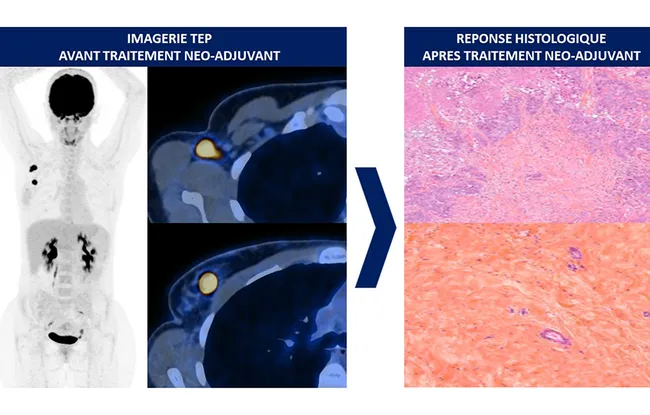- Home >
- Institut Curie News >
- Triple negative breast cancer: imaging to provide better care for patients
The nuclear medicine team at Institut Curie, headed by Dr. Laurence Champion (Saint-Cloud site), in collaboration with the Laboratory of Translational Imaging in Oncology unit (Inserm U1288), headed by Dr. Irène Buvat, assessed the contribution of metabolic imaging obtained by positron emission tomography (PET) combined with CT scan, commonly known as PET-scan, performed before neoadjuvant treatment in patients with early-stage triple negative breast cancer.
This study demonstrated that the tumor’s metabolic properties, measured using the PET image, help predict the pathological complete response (pCR), which is an indicator of a good prognosis related to a decreased risk of recurrence.
The pCR rate was 53% in the 91 patients treated using chemotherapy alone and 70% in the 100 patients treated using chemotherapy plus immunotherapy. The higher the tumor’s metabolic activity measurable on the PET image, and the smaller the tumor’s metabolic volume, the higher the probability of pCR. The combination of these metabolic data helps us determine the probability of pCR, by ranking the risk level.
Furthermore, the thyroid’s metabolic activity in patients before the start of treatment was correlated with the occurrence of permanent hyperthyroidism caused by the immunotherapy, thus requiring subsequent thyroid hormone replacement.
This work enables us to highlight the potential of PET imaging to adapt and optimize the care of patients according to their metabolic characteristics.
Until now PET imaging was used mainly to ascertain the spread of the disease and to rule out possible metastases. This multidisciplinary research project shows that FDG PET scans can also predict the effectiveness of the treatment and the potential side effects
Explains Dr. Romain-David Seban, nuclear physician at the Saint-Cloud site and leading author of the study.
These results emphasize the critical role of PET imaging and suggest it should be used to develop treatment strategies that are more tailored to patients, both more effective and better tolerated.
Reference: R-D. Seban et al.
[18F]FDG PET/CT for predicting triple-negative breast cancer outcomes after neoadjuvant chemotherapy with or without pembrolizumab
European Journal of Nuclear Medicine and Molecular Imaging (2023)
Research News
Discover all our news
Celebration
The Immunity and Cancer research unit (U932) celebrates its twentieth anniversary
12/12/2025
Artificial Intelligence
08/12/2025



